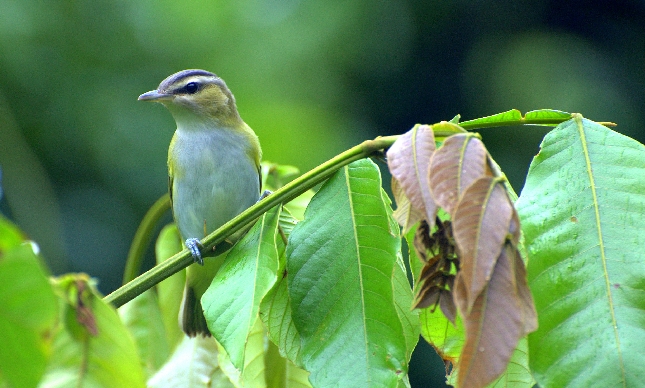
A recent incident in which 7,500 songbirds died after flying over a liquefied natural gas (LNG) plant has been ignored by the same conservative media outlets that often exaggerate the danger posed to birds by wind turbines, including hyping an incident in which a single bird was killed in Scotland.
The birds killed by the LNG facility, which may have included some endangered species, were headed south for the winter when a routine “flare” release at the Canaport LNG facility in Canada, used to burn off excess natural gas, drew them in. Though company officials apologized for the episode and said they are modifying equipment to reduce flaring, one manager at the plant admitted “At the moment there's not a whole lot I can do to resolve it in the short term.” The dead reportedly included “a large number of red-eyed vireos” (see photo above).
Three months prior, another migrating bird, the white-throated needletail, died after flying into a wind turbine off Scotland. The needletail is not endangered or threatened, but it is sighted only rarely in the United Kingdom.
Can you guess how conservative media covered these two cases?
Searches of Nexis, Google and an internal video database indicate that the thousands of birds that died after flying into a Canadian gas flare have not been mentioned by any U.S. conservative outlet to date (or any major U.S. outlet other than the environmental sites Treehugger and National Geographic).
Conversely, the single bird that flew into a wind turbine became a big story in the conservative media bubble. Right-wing outlets used the episode to smear green energy, sometimes betraying sheer glee, as when National Review Online blogger Greg Pollowitz wrote “Your [sic] laughing as you read this, aren't you?” or Rush Limbaugh remarked "[a] bunch of environmentalist whackos watched a precious windmill kill a rare bird."

Conservative media's fixation on a single bird death -- albeit regrettable -- while completely ignoring thousands more seems to let slip that feigning an interest in conservation is simply a convenient way for these outlets to attack wind power, which they have depicted as an agent of "mass slaughter " or an “open-ended aviary holocaust," while overlooking far more elementary, existential threats to wildlife, including climate change. Lest we forget, conservative media figures have regularly mocked those who are concerned about the impact that humans are having on animals -- one Fox News contributor declared “lots of species may be about to leave the planet, and I don't care” -- and attacked conservation efforts for endangered species from lizards to polar bears.
Even using high bird mortality estimates that have been disputed by the wind industry, the toll exacted by U.S. wind turbines represents only a fraction of those attributed to power lines, buildings, cars and toxic chemicals*:

A study authored by the same scientist who acknowledged a need to "re-evaluate" gas flaring in the wake of the Canaport incident found that domestic cats kill between 1.4 billion and 3.7 billion birds per year in the continental U.S., making them “likely the single greatest source of anthropogenic mortality for US birds and mammals.” Even using the low-end number for cat-caused bird deaths and the highest available estimate for wind-caused deaths, cats kill more than 2,400 times as many birds as do wind turbines each year. Be sure to send Limbaugh a tip the next time Fluffy brings a sparrow into the house.
As the Canaport incident indicates, fossil fuels aren't exactly blameless either. Coal mining practices have been linked to the decline of some bird habitats, and the U.S. Fish and Wildlife Service has estimated that up to 1 million birds are killed in oilfield production pits each year. Not only are right-wing media loath to report on these threats, they regularly dismiss the importance of addressing climate change driven by the burning of fossil fuels. Research has shown that global warming is already decreasing some bird populations and may lengthen migration distances, and the author of a recent study on these and other shifts told The Washington Post in June 2013 that migratory birds “are among the most vulnerable groups of species to climate change.”
None of this obviates the need to carefully site turbines and minimize wildlife impacts, but the wind industry and conservationists have been working together to do just that as this renewable energy source continues its rapid growth. The federal government released new guidelines to curtail bird deaths in 2012, and bird groups have applauded the move.
While environmental groups have worked to balance the benefits and costs of wind power, conservative media simply aren't credible conservation critics.
Second graph created by Jill Fitzsimmons.
*Chart has been updated for clarity.
